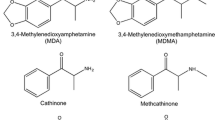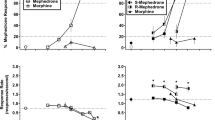Abstract
The drug discrimination paradigm was used to evaluate in rats the ability of the discriminate response to either 0.8 mg/kgd-amphetamine or 0.8 mg/kgl-cathinone to generalize to 2.4–6.0 mg/kg of the active cathinone metabolited-norpseudoephedrine, also known as cathine. When tested 24 h after vehicle administration, cathine generalized in a dose-related fashion in rats (n=6) trained with cathinone (ED50=3.03 mg/kg) and in rats (n=8) trained with amphetamine (ED50=2.93 mg/kg). In contrast, when cathine was tested 24 h after the administration of either amphetamine or cathinone, it produced significantly decreased discriminative performance. The possibility that this acute tolerance may have been produced by release, and subsequent depletion, of brain dopamine was tested by pretreating rats with the dopamine release inhibitor CGS 10746B. When CGS 10746B was administered prior to cathinone it significantly decreased cathinone discrimination. In addition, acute tolerance to cathine at 24 h after vehicle-cathinone co-administration was reversed when cathine was tested 24 h after CGS 10746B-cathinone co-administration. The results suggest that cathinone-produced discriminative stimulus, as well as the acute tolerance to cathine, may be dopaminergically mediated.
Similar content being viewed by others
References
Alles G, Fairchild D, Jensen M (1961) Chemical pharmacology ofCatha edulis. J Med Pharm Chem 3:323–352
Altar CA, Wasley AM, Liebman J, Gerhardt S, Kim H, Welch JJ, Wood PL (1985) CGS 10746B: an atypical antipsychotic candidate that selectively decreases dopamine release at behaviorally effective doses. Life Sci 39:699–705
Barrett RJ, Leith NJ (1981) Tolerance to the discriminative stimulus properties ofd-amphetamine. Neuropharmacology 20:251–255
Bowman NC, Rand MJ (1980) Textbook of pharmacology, second edition. Blackwell, London, pp 39.51–39.52
Brenneisen R, Geisshüsler S, Schorno X (1986) Metabolism of cathinone to (−)-norephedrine and (−)-norpseudoephedrine. J Pharmacol 38:298–300
Caldwell J, Dring LG, Williams RT (1972) Norephedrine as metabolites of [14C] amphetamine in urine in man. Biochem J 129:23–24
Foltin RW, Schuster CR (1982) Behavioral tolerance and cross-tolerance todl-cathinone andd-amphetamine in rats. J Pharmacol Exp Ther 222:126–131
Foltin RW, Woolverton W, Schuster C (1983) Effects of psychomotor stimulants, alone and in pairs, on milk drinking in the rat after intraperitoneal and intragastric administration. J Pharmacol Exp Ther 226:411–418
Giannini AJ, Castellani S (1982) A manic-like psychosis due to khat. J Toxicol Clin Toxicol 19:455–459
Glennon R, Showalter D (1981) The effect of cathinone and several related derivatives on locomotor activity. Res Commun Subst Abuse 2:186–192
Glennon RA, Schechter MD, Rosecrans J (1984a) Discriminative stimulus properties of S(−)- and R(+)-cathinone, and (+)-cathine and several structural modifications. Pharmacol Biochem Behav 21:1–3
Glennon RA, Young R, Hauck AG, McKenney JD (1984b) Structure-activity studies on amphetamine analogues using drug discrimination methodology. Pharmacol Biochem Behav 21:895–901
Goudie AJ (1985) Temporal parameters of the discriminative stimulus and rate-suppressant properties of the psychostimulant,Dl-cathinone: possible relevance to prediction to drug dependence potential. IRCS Med Sci 13:966–967
Groves P, Rebec G (1976) Biochemistry and behavior: some central actions of amphetamine and antipsychotic drugs. Annu Rev Psychol 27:91–127
Halbach H (1972) Medical aspects of the chewing of Khat leaves. Bull WHO 47:21–29
Kalix P (1981) Cathinone, an alkaloid from khat leaves with an amphetamine-like releasing effect. Psychopharmacology 74:269–270
Kalix P (1983) Mechanism of action of (−)-cathinone, a new alkaloid from Khat leaves. Alcohol Alcohol 18:301–303
Kalix P (1984) The pharmacology of Khat. Gen Pharmacol 15:179–187
Kalix P, Braenden O (1985) Pharmacological aspects of the chewing of khat leaves. Pharmacol Rev 37:149–164
Knoll J (1979) Studies on the central effects of (−)cathinone. In: Problems of drug dependence. NIDA Res Monogr 27, US Government Printing Office, Washington, DC, pp 322–323
Levine RR (1978) Pharmacology: drug actions and reactions, 2nd edn. Little, Brown and Co., Boston, pp 279–280
Litchfield JT, Wilcoxon F (1949) A simplified method of evaluating dose-effect experiments. J Pharmacol Exp Ther 96:99–113
Luqman W, Danowski T (1976) The use of khat in Yemen: social and medical observations. Ann Int Med 85:246–249
Mattai C, Mugera G (1975) Excretion of the active principle ofCatha edulis (Miraa) in human urine. J Pharmacol Sci 64:702–703
May S, Phillips R, Hermann H, Mueller P (1982) Bioactivation ofCatha edulis alkaloids: enzymatic ketonization of norpseudoephedrine. Biochem Biophys Res Commun 104:38–44
Modrow HE, Holloway FA, Carney JM (1981) Caffeine discrimination in the rat. Pharmacol Biochem Behav 14:683–688
Nencini P, Ahmed A, Amiconi G, Elmi A (1984) Tolerance develops to the sympathetic effects of khat in humans. Pharmacology 28:150–154
Nielsen JA, Schechter MD (1985) Behavioral and neurochemical effects of (−)- and (±)-cathinone: dose-response and time-course. Prog Neuropsychopharmacol Biol Psychiatry 9:739–743
Peterson DW, Maitai CK, Sparber SB (1980) Relative potencies of two phenylalkylamines found in the abused plant,Catha edulis, khat. Life Sci 27:2143–2147
Schechter MD (1986a) Dopaminergic mediation of a behavioral effect of cathinone. Pharmacol Biochem Behav 25:337–340
Schechter MD (1986b) Induction and recovery from tolerance to the discriminative stimulus properties ofl-cathinone. Pharmacol Biochem Behav 25:13–16
Schechter MD, Boja JW (1988) CGS 10746B is able to attenuate the effects of amphetamine: further evidence for dopaminergic mediation. Pharmacol Biochem Behav 30:1089–1092
Schechter MD, Rosecrans JA, Glennon RA (1984) Comparison of the behavioral effects of cathinone, amphetamine and apomorphine. Pharmacol Biochem Behav 20:181–184
Szendrei K (1980) The chemistry of khat. Bull Narc 32:5–36
Wagner G, Preston K, Ricaurte G, Schuster C, Seiden L (1982) Chemical similarities betweend, l-cathinone andd-amphetamine. Drug Alcohol Depend 9:279–284
Zelger JL, Carlini EA (1980) Anorexigenic effects of two amines obtained fromCatha edulis Forsk. (khat) in rats. Pharmacol Biochem Behav 12:701–705
Author information
Authors and Affiliations
Rights and permissions
About this article
Cite this article
Schechter, M.D. Rats become acutely tolerant to cathine after amphetamine or cathinone administration. Psychopharmacology 101, 126–131 (1990). https://doi.org/10.1007/BF02253729
Received:
Revised:
Issue Date:
DOI: https://doi.org/10.1007/BF02253729




